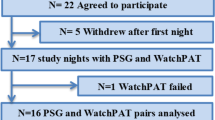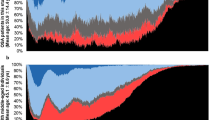Abstract
Objective:
We sought to ascertain the validity of two screening scales for obstructive sleep apnea (OSA) in pregnancy and to establish the prevalence of OSA in pregnancy.
Study Design:
In this prospective observational study, two screening scales were administered. Screen positive subjects were referred for diagnostic polysomnography (PSG); if admitted for antepartum care, screen positive subjects underwent a modified study with a type 3 device (T3D).
Result:
A total of 1509 subjects underwent OSA screening; 58 completed diagnostic testing. Neither measure was a reliable diagnostic tool for OSA as determined by T3D or PSG (detection rates of 10.3% and 18.0%, respectively). Among screen positive subjects undergoing PSG or T3D testing, 15.5% ultimately met ‘gold standard’ OSA diagnostic criteria for an estimated point prevalence of 4.9%.
Conclusion:
In this prospective trial, screening positive on the Berlin questionnaire or Epworth sleepiness scale was poorly predictive of OSA among gravidae and was associated with a high false referral rate.
This is a preview of subscription content, access via your institution
Access options
Subscribe to this journal
Receive 12 print issues and online access
$259.00 per year
only $21.58 per issue
Buy this article
- Purchase on Springer Link
- Instant access to full article PDF
Prices may be subject to local taxes which are calculated during checkout


Similar content being viewed by others
References
Dempsey JA, Veasey SC, Morgan BJ, O’Donnell CP . Pathophysiology of sleep apnea. Physiol Rev 2010; 90 (1): 47–112.
Lurie A . Obstructive sleep apnea in adults: epidemiology, clinical presentation, and treatment options. Adv Cardiol 2011; 46: 1–42.
Iber C, Ancoli-Israel S, Chesson A, Quan SF . The AASM Manual for the Score of Sleep and Associated Events: Rules, Terminology, and Technical Specifications 1st edn Westchester, Illinois: American Academy of Sleep Medicine, 2007.
Netzer NC, Stoohs RA, Netzer CM, Clark K, Strohl KP . Using the Berlin Questionnaire to identify patients at risk for the sleep apnea syndrome. Ann Intern Med 1999; 131 (7): 485–491.
Johns MW . A new method for measuring daytime sleepiness: the Epworth sleepiness scale. Sleep 1991; 14 (6): 540–545.
Johns MW . Sensitivity and specificity of the multiple sleep latency test (MSLT), the maintenance of wakefulness test and the epworth sleepiness scale: failure of the MSLT as a gold standard. J Sleep Res 2000; 9 (1): 5–11.
Sharma SK, Vasudev C, Sinha S, Banga A, Pandey RM, Handa KK . Validation of the modified Berlin questionnaire to identify patients at risk for the obstructive sleep apnoea syndrome. Indian J Med Res 2006; 124 (3): 281–290.
Olivarez SA, Maheshwari B, McCarthy M, Zacharias N, van den Veyver I, Casturi L et al. Prospective trial on obstructive sleep apnea in pregnancy and fetal heart rate monitoring. Am J Obs Gynecol 2010; 202 (6): 552 e1–552 e7.
Facco FL, Ouyang DW, Zee PC, Grobman W A . Development of a pregnancy-specific screening tool for sleep apnea. J Clin Sleep Med 2012; 8 (4): 389–394.
Wilson DL, Walker SP, Fung AM, O’Donoghue F, Barnes M, Howard M . Can we predict sleep-disordered breathing in pregnancy? The clinical utility of symptoms. J Sleep Res 2013; 22 (6): 670–678.
Bourjeily G, Raker CA, Chalhoub M, Miller MA . Pregnancy and fetal outcomes of symptoms of sleep-disordered breathing. Eur Respir J. 2010; 36 (4): 849–855.
Olivarez SAA, Ferres M, Antony K, Mattewal A, Maheshwari B, Sangi-haghpeykar H et al. Obstructive sleep apnea screening in pregnancy, perinatal outcomes, and impact of maternal obesity. Am J Perinatol 2011; 28 (8): 651–658.
Louis JM, Auckley D, Sokol RJ, Mercer BM . Maternal and neonatal morbidities associated with obstructive sleep apnea complicating pregnancy. Am J Obs Gynecol 2010; 202 (3): 261 e1–261 e5.
Chen YH, Kang JH, Lin CC, Wang IT, Keller JJ, Lin HC . Obstructive sleep apnea and the risk of adverse pregnancy outcomes. Am J Obs Gynecol 2012; 206 (2): 136 e1–5.
Sahin FK, Koken G, Cosar E, Saylan F, Fidan F, Yilmazer M et al. Obstructive sleep apnea in pregnancy and fetal outcome. Int J Gynaecol Obstet 2008; 100 (2): 141–146.
Sahota PK, Jain SS, Dhand R . Sleep disorders in pregnancy. Curr Opin Pulm Med 2003; 9 (6): 477–483.
Izci B, Riha RL, Martin SE, Vennelle M, Liston WA, Dundas KC et al. The upper airway in pregnancy and pre-eclampsia. Am J Respir Crit Care Med 2003; 167 (2): 137–140.
Pilkington S, Carli F, Dakin MJ, Romney M, De Witt KA, Dore CJ et al. Increase in Mallampati score during pregnancy. Br J Anaesth 1995; 74 (6): 638–642.
Rosenthal LD, Dolan DC . The Epworth sleepiness scale in the identification of obstructive sleep apnea. J Nerv Ment Dis 2008; 196 (5): 429–431.
Guilleminault C, Kreutzer M, Chang JL . Pregnancy, sleep disordered breathing and treatment with nasal continuous positive airway pressure. Sleep Med 2004; 5 (1): 43–51.
Connolly G, Razak AR, Hayanga A, Russell A, McKenna P, McNicholas WT . Inspiratory flow limitation during sleep in pre-eclampsia: comparison with normal pregnant and nonpregnant women. Eur Respir J. 2001; 18 (4): 672–676.
Nigro CA, Serrano F, Aimaretti S, Gonzalez S, Codinardo C, Rhodius E . Utility of ApneaLink for the diagnosis of sleep apnea-hypopnea syndrome. Med (B Aires) 2010; 70 (1): 53–59.
Antony KM, Agrawal A, Arndt ME, Murphy AM, Alapat PM, Guntupalli KK et al. Association of adverse perinatal outcomes with screening measures of obstructive sleep apnea. J Perinatol Press 2014; 28: 651–658.
Pepe MS, Etzioni R, Feng Z, Potter JD, Thompson ML, Thornquist M et al. Phases of biomarker development for early detection of cancer. J Natl Cancer Inst 2001; 93 (14): 1054–1061.
Franklin KA, Holmgren PA, Jonsson F, Poromaa N, Stenlund H, Svanborg E . Snoring, pregnancy-induced hypertension, and growth retardation of the fetus. Chest 2000; 117 (1): 137–141.
Facco FL, Kramer J, Ho KH, Zee PC, Grobman WA . Sleep disturbances in pregnancy. Obs Gynecol 2010; 115 (1): 77–83.
Hutchison BL, Stone PR, McCowan LME, Stewart AW, Thompson JMD, Mitchell E a . A postal survey of maternal sleep in late pregnancy. BMC Pregnancy and Childbirth 2012; 12 (1): 144.
Schiza SE, Bouloukaki I, Mermigkis C, Bourjeily G, El Sabbagh R, Sawan P et al. Epworth sleepiness scale scores and adverse pregnancy outcomes. Sleep Breath 2013; 17 (4): 1125–1126.
Edwards N, Blyton DM, Kirjavainen TT, Sullivan CE . Hemodynamic responses to obstructive respiratory events during sleep are augmented in women with preeclampsia. Am J Hypertens 2001; 14 (11 Pt 1): 1090–1095.
Guilleminault C, Palombini L, Poyares D, Takaoka S, Huynh NT, El-Sayed Y . Pre-eclampsia and nasal CPAP: part 1. Early intervention with nasal CPAP in pregnant women with risk-factors for pre-eclampsia: preliminary findings. Sleep Med 2007; 9 (1): 9–14.
Poyares D, Guilleminault C, Hachul H, Fujita L, Takaoka S, Tufik S et al. Pre-eclampsia and nasal CPAP: part 2. Hypertension during pregnancy, chronic snoring, and early nasal CPAP intervention. Sleep Med 2007; 9 (1): 15–21.
Oktay B, Rice TB, Atwood CW Jr., Passero M Jr., Gupta N, Givelber R et al. Evaluation of a single-channel portable monitor for the diagnosis of obstructive sleep apnea. J Clin Sleep Med 2011; 7 (4): 384–390.
Ralls FM, Grigg-Damberger M . Roles of gender, age, race/ethnicity, and residential socioeconomics in obstructive sleep apnea syndromes. Curr Opin Pulm Med 2012; 18 (6): 568–573.
O’Brien LM, Bullough AS, Shelgikar A V, Chames MC, Armitage R, Chervin RD . Validation of Watch-PAT-200 against polysomnography during pregnancy. J Clin Sleep Med 2012; 8 (3): 287–294.
Louis J, Auckley D, Miladinovic B, Shepherd A, Mencin P, Kumar D et al. Perinatal outcomes associated with obstructive sleep apnea in obese pregnant women. Obs Gynecol 2012; 120 (5): 1085–1092.
Acknowledgements
We thank Lata Casturi, RPGST at Baylor College of Medicine; ResMed for the use of the ResMed ApneaLink devices; and staff and nurses at Casa de Amigos, People’s Health Center and Ben Taub General Hospital Obstetrics Clinic and Antepartum Unit. KM Aagaard was supported by a DP2 award (DP21DP2OD001500-01 NIH Director New Innovator Award). This study was financially supported by the Baylor College of Medicine Department of Obstetrics and Gynecology Resident Research Grant 2011-2012 (to KM Antony). ResMed donated single-use nasal cannulas and oximeter sensors for this study.
Author information
Authors and Affiliations
Corresponding author
Ethics declarations
Competing interests
The authors declare no conflict of interest.
Rights and permissions
About this article
Cite this article
Antony, K., Agrawal, A., Arndt, M. et al. Obstructive sleep apnea in pregnancy: reliability of prevalence and prediction estimates. J Perinatol 34, 587–593 (2014). https://doi.org/10.1038/jp.2014.48
Received:
Revised:
Accepted:
Published:
Issue Date:
DOI: https://doi.org/10.1038/jp.2014.48
This article is cited by
-
Validation of the Apnealink Air for diagnosis of obstructive sleep apnoea (OSA) in pregnant women in early-mid gestation
Sleep and Breathing (2024)
-
Respiratory and Airway Considerations in Obstetric Patients
Current Anesthesiology Reports (2019)
-
Screening for Obstructive Sleep Apnea: Should We Do It?
Current Pulmonology Reports (2019)
-
Obstructive sleep apnea in pregnancy: performance of a rapid screening tool
Sleep and Breathing (2019)
-
Sleepiness and sleep-disordered breathing during pregnancy
Sleep and Breathing (2016)



